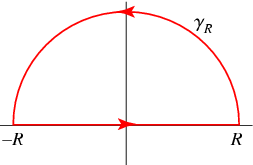How do I calculate the Fourier Transform of #a/(2pi) 1/(a^2 + x^2)#?
Define #mathcal(F)_(omega)[f(x)] = hat(f)(omega)# as the Fourier transform of #f(x)# :
#hat(f)(omega) -= mathcal(F)_(omega)[f(x)] = 1/(sqrt(2pi)) int_(-oo)^(oo) f(x)e^(-iomegax)dx#
and define the inverse Fourier transform #mathcal(F)_(x)^(-1)[hat(f)(omega)]# of #hat(f)(omega)# as:
#f(x) -= mathcal(F)_(x)^(-1)[hat(f)(omega)] = 1/(sqrt(2pi)) int_(-oo)^(oo) hat(f)(omega) e^(iomegax)dx#
How would I evaluate a Fourier Transform with:
#f(x) = a/(2pi) 1/(a^2 + x^2)# ?
Define
#hat(f)(omega) -= mathcal(F)_(omega)[f(x)] = 1/(sqrt(2pi)) int_(-oo)^(oo) f(x)e^(-iomegax)dx#
and define the inverse Fourier transform
#f(x) -= mathcal(F)_(x)^(-1)[hat(f)(omega)] = 1/(sqrt(2pi)) int_(-oo)^(oo) hat(f)(omega) e^(iomegax)dx#
How would I evaluate a Fourier Transform with:
#f(x) = a/(2pi) 1/(a^2 + x^2)# ?
1 Answer
# int_(-oo)^(oo) \ e^(i omega x )/(a^2+x^2) \ dx = (pi e^(-omega a ))/(a) #
Explanation:
I never studied Fourier Transforms, but at the end of the day it is just an integral transform similar to Laplace, so:
I won't worry about the
# I_x = int_(-oo)^(oo) \ e^(i omega x )/(a^2+x^2) \ dx # where#x in RR# .
In order to compute this definite integral, consider the following complex variable function over a domain
# f(z) = e^(i omega z )/(a^2+z^2) #
And its associated contour integral:
# I_z = oint_C \ f(z) \ dz #
Where
We will restrict
We need only be concerned with the poles in Q1 and Q2, that (providing we make
So then:
# oint_C \ f(z) \ dz = int_(-R)^(R) \ f(x) \ dx + int_(gamma_R) \ f(z) \ dz #
As
# alpha = ai # (assuming#a gt 0# )
Then by the residue theorem:
# oint_C \ f(z) \ dz = 2pii xx ( ("sum of the residues of the"), ("poles of " f(z) " within "C) ) #
# " " = 2pii \ { res_(z=alpha) \ f(z) #
And we can calculate the residues as follows:
# res_(z=alpha) = lim_(z rarr alpha) (z-alpha) f(z) #
# " " = lim_(z rarr ai) (z-ai) ( e^(i omega z )/(a^2+z^2) ) #
# " " = lim_(z rarr ai) (z-ai) ( e^(i omega z )/((z-ai)(z+ai)) ) #
# " " = lim_(z rarr ai) ( e^(i omega z )/(z+ai) ) #
# " " = e^(i omega ai )/(ai+ai) #
# " " = e^(-omega a )/(2ai) #
Thus:
# oint_C \ f(z) \ dz = 2pii e^(-omega a )/(2ai) = (pi e^(-omega a ))/(a) #
Now, as we let
# oint_C \ f(z) \ dz = int_(-oo)^(oo) \ f(x) \ dx + int_(gamma_R) \ f(z) \ dz #
As is often the case with contour integrals, we find that:
# lim_(R rarr oo) int_(gamma_R) \ f(z) \ dz = 0 #
So we will end up with the result:
# int_(-oo)^(oo) \ e^(i omega x )/(a^2+x^2) \ dx = oint_C \ f(z) \ dz #
# " " = (pi e^(-omega a ))/(a) #



